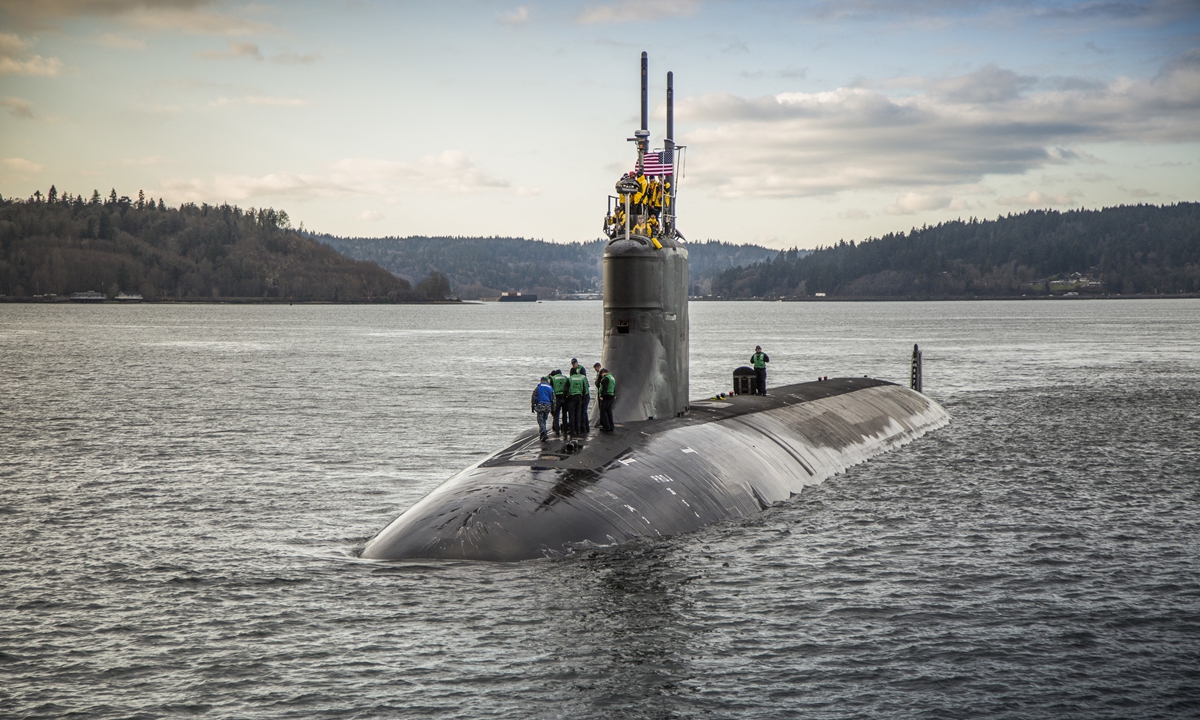
File photo of USS Connecticut (Photo: AFP)
The "unknown object" the USS Connecticut nuclear-powered submarine collided with in the South China Sea in early October turns out to be an uncharted seamount, the US 7th Fleet announced on Monday. But Chinese military experts said on Tuesday that the US statement is disappointing because it remains short and unclear, leaving many questions unanswered, including the exact location and the impact on the environment, which were demanded by the Global Times in an online petition launched last week and has so far been signed up by 330,000 Chinese and foreign netizens.
A nuclear leakage could have taken place, and a recent flight of a US nuclear material detection aircraft to the South China Sea shows the US understands the possibility, experts said.
The command investigation for the USS Connecticut determined that the submarine "grounded on an uncharted seamount while operating in international waters in the Indo-Pacific region," the US 7th Fleet said in the statement on Monday.
It has been one month since the Seawolf-class nuclear-powered submarine had the accident. The US Navy announced on October 7 that the submarine hit an "unknown object" on October 2 while submerged in the South China Sea that left more than 10 sailors injured and caused a partial damage to the submarine.
But the latest US statement remains short and unclear, and it still does not answer many questions that concern the international community, Zhang Junshe, a senior research fellow at the Naval Research Academy of the People's Liberation Army (PLA), told the Global Times on Tuesday.
This includes the exact location where the collision took place, the mission the submarine was on during the accident, and if the collision has resulted in nuclear leakage and polluted the maritime environment, Zhang said.
As about 100,000 commercial ships sail in the South China Sea each year plus a vast number of fishing ships, this means the maritime environment, navigation safety and safety for fishing work are the common interests of the international community, which deserves to know the truth and details of the accident, Zhang said, noting the current investigation results "lack sincerity, transparency and professionalism, making it disappointing."
Despite the US Navy having denied the submarine's nuclear reactor or propulsion system was damaged, Chinese military expert and TV commentator Song Zhongping told the Global Times on Tuesday that grounding on a seamount could damage the submarine and lead to a nuclear leakage.
The US recently deployed a nuclear material detection aircraft into the South China Sea for a survey, and this shows the possibility of a nuclear leakage, Song said.
The nuclear material detection aircraft Song referred to is the WC-135W, which was found operating in the South China Sea on Sunday, according to the monitoring conducted by the South China Sea Strategic Situation Probing Initiative, a Beijing-based think tank.
Analysts said that by not revealing the details of the collision, the US is intentionally hiding something.
Last week, the Global Times launched an online petition, demanding the US military to reveal the above-mentioned information on the collision, with about 330,000 Chinese and foreign netizens having signed up as of Tuesday.
While the direct reason for the collision could be that the US Navy failed to get an accurate sea map due to the complicated environment of the South China Sea and the possible changes of underwater terrain after earthquakes and volcano eruptions. The root of the accident is the US' long-term presence in the South China Sea that stirs up trouble in the region aiming to gain selfish geopolitical interests, experts said, listing the recent muscle-flexing drill by the US and Japan warships in the region as an example.
"It is not a surprise that collision accidents could happen," Zhang said. Warships of the US 7th Fleet have had several collision accidents over the past years.
For example, in 2017, the USS Fitzgerald destroyer collided with a container ship near Japan, resulting in seven deaths and several injuries.
Later in 2017, the USS John S. McCain destroyer collided with a chemical tanker in the South China Sea, leading to 10 deaths.


